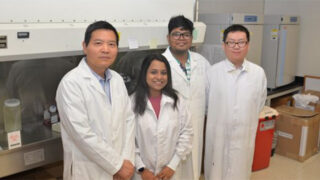Areas of Study
Bacterial pathogenesis and vaccine development
Education
- Shanghai Institute of Pharmaceutical Industry2004PhD
Research
My lab focuses on investigating the interaction between pathogenic Yersinia and hosts, developing vaccines against respiratory bacterial pathogens (Yersinia pestis, Pseudomonas aeruginosa, and Streptococcus pneumoniae), and understanding lung protective immunity induced by vaccines.
Vaccines against plague and yersiniosis
Yersinia pestis has caused three major pandemics in human history, resulting in over 100 million deaths. Due to its deadly character, Y. pestis is listed as a Tier 1 Select agent by the CDC. Y. enterocolitica and Y. pseudotuberculosis are food-borne bacterial pathogens that cause yersiniosis in humans and cause significant illnesses in the United States each year. No licensed plague and yersiniosis vaccines are available yet. We are seeking to develop an optimal live Yersinia vaccine or a recombinant Yersinia platform to generate outer membrane vesicles (OMVs) as acellular vaccines against plague and yersiniosis.
Vaccines against drug-resistant Pseudomonas aeruginosa infection
P. aeruginosa (PA) is one of the major opportunistic Gram-negative bacterial pathogens. PA is listed as one of the leading nosocomial pathogens responsible for life-threatening pneumonia, surgical infection, and bacteremia, especially among immunocompromised subjects with underlying diseases such as cancer, AIDS, or cystic fibrosis (CF), and patients in intensive care units. Along with surges of multi-drug-resistant (MDR) and extreme drug-resistant (XDR) PA in health care settings, the treatment of PA infections is becoming extremely challenging. Therefore, developing an effective vaccine is imperative to prevent PA infection and reduce the spread of MDR and XDR PA. We are seeking to develop an effective vaccine to prevent the drug-resistant PA prevalent in health care settings.
Protective immunity induced by vaccines
We are investigating how the lung protective immunity induced by vaccination with respective vaccines provides fundamentals for the rational development of prophylactics for counteracting infections of different respiratory pathogens.
Hemochromatosis and ferrophilic Yersinia infection
Hemochromatosis due to genetic, dietary, or iatrogenic (hemodialysis, frequent blood transfusion) conditions predisposes individuals to infections by a variety of pathogens. Hereditary hemochromatosis (HH) due to the HfeC282Y/C284Y mutation is an iron overload disorder that causes increased intestinal iron absorption and accumulation of excessive iron in the liver, heart, and other organs. HH is among the most common genetic disorders in the United States and Caucasians. Clinical evidence indicates that individuals with HH, sickle-cell disease, thalassemia, or liver cirrhosis manifesting hemochromatotic disorders are prone to infections by food-borne pathogens, such as Yersinia and Vibrio vulnificus, which cause serious complications, even sepsis. However, the underlying mechanisms leading to these clinical and experimental observations remain elusive. Currently, we are using ferrophilic Y. pseudotuberculosis and Y. enterocolitica to understand how ferrophilic bacteria cause severe infections through the gut in iron overload mice.
Publications
Majumder S, Das S, Li P, Yang N, Dellario H, Sui H, Guan Z, Sun W. Pneumonic plague protection induced by a monophosphoryl lipid A decorated Yersinia outer-membrane-vesicle vaccine. Small. 2023, 2307066.
Amit K Singh, Saugata Majumder, Xiuran Wang, Renjie Song, Wei Sun#. Lung Resident Memory T Cells Activated by Oral Vaccination Afford Comprehensive Protection against Pneumonic Yersinia pestis Infection. J Immunol. 2023, 210(3):259-270.
Saugata Majumder, Rachel M. Olson, Amit Singh, Xiuran Wang, Peng Li, Hatem Kittana, Paul E. Anderson, Deborah M. Anderson, and Wei Sun#. Protection induced by oral vaccination with a recombinant Yersinia pseudotuberculosis delivering Y. pestis LcrV and F1 antigens in mice and rats against pneumonic plague. Infect Immun. 2022, 90(8):e0016522.
Xiuran Wang, Peng Li, Amit K. Singh, Xiangmin Zhang, Ziqiang Guan, Roy Curtiss 3rd and Wei Sun#. Remodeling Yersinia pseudotuberculosis to generate a highly immunogenic outer membrane vesicle vaccine against pneumonic plague. PNAS, 2022, 119 (11) e2109667119.
Shreya Das, Mohd Saqib, Ryan C Meng, Sridar V. Chittur, Ziqiang Guan, Fengyi Wan, and Wei Sun#. Hemochromatosis drives acute lethal intestinal responses to hyperyersiniabactin-producing Yersinia pseudotuberculosis. PNAS, 2022, 119(2): e2110166119.
Peng Li, Xiuran Wang, Xiangwan Sun, Ziqiang Guan, and Wei Sun#. Outer membrane vesicles displaying a heterologous PcrV-HitA fusion antigen promote protection against pneumonic Pseudomonas aeruginosa infection. mSphere, 2021. DOI: 10.1128/mSphere.00699-21.
Peng Li, Xiuran Wang, Xiangwan Sun, Jesse Cimino, Ziqiang Guan, and Wei Sun#. Recombinant Pseudomonas bio-nanoparticles induce protection against pneumonic Pseudomonas aeruginosa infection. Infection and Immunity, 2021. DOI: 10.1128/IAI.00396-21.
Peng Li, Xiuran Wang, Carol Smith, Yixin Shi, Joseph T Wade, and Wei Sun#. Dissecting the psa locus regulation in Yersinia pestis. Journal of Bacteriology, 2021. DOI: 10.1128/JB.00237-21.
Xiuran Wang, Amit K. Singh, Xiangming Zhang, and Wei Sun. Induction of protective anti-plague immune responses by self-adjuvanting bionanoparticles derived from engineered Yersinia pestis. Infection and Immunity, 2020. 88: e00081-20.
Amit K. Singh, Roy Curtiss 3rd and Wei Sun#. A recombinant attenuated Yersinia pseudotuberculosis vaccine delivering a YopENt138-LcrV fusion elicits broad protection in mice against plague and yersiniosis. Infection and Immunity, 2019, 87(10): e00296-19.
View Wei Sun's articles on the National Institute of Health's PubMed website.
